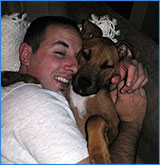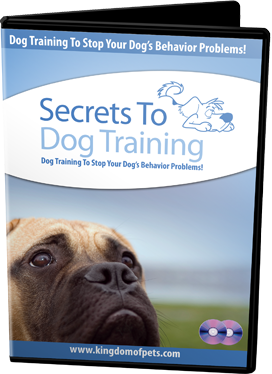If you are looking for the greatest gold-mine of easy to use "change your dog's behavior" advice ever crammed into a newsletter series then read on!
Also, make sure that you check out our 100% authentic testimonials from people who have bought Secrets to Dog Training and find out the massive difference it has made to their owner-dog relationship!
 "Hi Daniel, I was given an american staffordshire when he was four months and had never had a puppy before. I was looking around for a good training manual and came across Secrets to Dog Training. I have used it right from the beginning and am abslutely amazed at how much I have learnt and how much progress Lincoln has made in the short time using the SitStyFetch guide. I am now looking at starting Lincoln on some advanced learning techniques and am very confident in usind the guide to help him along."
"Hi Daniel, I was given an american staffordshire when he was four months and had never had a puppy before. I was looking around for a good training manual and came across Secrets to Dog Training. I have used it right from the beginning and am abslutely amazed at how much I have learnt and how much progress Lincoln has made in the short time using the SitStyFetch guide. I am now looking at starting Lincoln on some advanced learning techniques and am very confident in usind the guide to help him along."
-- Mark De Mercurio (USA)
Dear Daniel,
My six year old Chocolate Lab has dandruff. It's not sticky or smelly, just dry and flaky, mostly on his back. There are so many products advertised for this condition, everything from fish oil to shampoo, I'm really confused. Is there a simple way to treat the dandruff?
Thank you so much.
Shelly
Hi there Shelly,
Thank you for your email regarding your 6 year old Chocolate lab and his current dandruff problem. These cases can be due to a large number of causes, and it usually boils down to you having to take your dog to your local Veterinarian. They will then undertake the necessary tests so that the correct diagnosis can be made and thus treatment can be given.
In order to give you some idea of the possible causes for 'doggy dandruff' or in the Veterinary world - "Scale" I have written up a little bit on them for you.
Dandruff or Scale are terms used for the accumulation of dried, dead skin cells. As I say, this may happen for a large variety of reasons, and it is always best to take your dog to your local Veterinarian to see the problem first hand, as oftentimes the scale can be secondary to another health related problem.
A few things that can lead to dryness include poor diet, low humidity (especially common in the winter), and too infrequent grooming to distribute the oils are all common causes of dandruff that could be affecting your Chocolate Lab in particular. The skin is the largest organ of the body and is used to rid the body of toxins. The only way to keep those toxins from coming out through the skin is to prevent the toxins from getting inside the animal in the first place. A very thin layer of fat and waxes, called sebum, normally prevents the moisture in the skin from escaping into the air. Some animals do not receive enough dietary fat, or cannot absorb the fat, to form a good sebum layer. If you are feeding a dry pet food, you can try adding 1 to 3 teaspoons of vegetable oil to the food per day. If bowel movements become soft or greasy, digestive examinations may be needed.
Diseases that cause an excessive loss of body water in the urine or bowel movement, such as diabetes mellitus, kidney failure, or chronic diarrhea, will cause dryness of the skin and dandruff. Again, please consult your veterinarian if your chocolate lab has diarrhea, or excessive thirst or urination.
Any chronic irritation of the skin will speed up the skin reproduction rate and cause dandruff. One common irritant to the skin's surface on the back is a mite that burrows through the outermost layer of the skin. This mite is barely visible as a white speck if put on black paper. Since it can move around it is called the "Walking Dandruff" or in the Veterinary world Cheyletiella mite. Treatment involves the use of insecticides under the direction of your veterinarian. Fleas can cause dandruff over the hips. Scabies causes dandruff on the ears and elbows of dogs.
There are rare causes of dandruff that are inherited or the cause is unknown. Examples include seborrhea, psoriasis, and ichthyosis. If routine efforts to control dandruff in your dog fail, your Veterinarian may seek further assistance by referring you to a Veterinary dermatologist.
Flakes from the surface of the skin may not be skin cells. Substances applied to the skin which dry and flake may mimic dandruff. Shampoos, conditioners, and other skin cosmetics should be thoroughly rinsed after application to the skin. Keep in mind, too, that the presence of itching can indicate other factors such as fleas, lice or mange mites.
If your dog has white skin flakes around the neck, back or rump, he's probably got dandruff and there are some things that you can do. First, do not use shampoos made for human beings on your pet, especially not baby shampoos or medicated shampoos. A dog's skin has different ph level than human skin, so the chemicals in people shampoo can actually harm your pet's skin. In Veterinary terms we like to say "Primum Non Nocere" or in English - first do no harm. Instead, try using dry skin and seborrhic shampoos especially for dogs. These shampoos contain sulfur or salicylic acid. Be sure to follow the directions on the label. Make sure that you thoroughly rinse your dog after shampooing. The shampoo residue can cause your dog to itch and scratch. Fatty acid supplements such as Drs. Foster & Smith Vitacaps or Vitacoat and oatmeal shampoos could be helpful for the coat and for the removal of dander.
If your dog continues itching, scratching, whimpering, or is otherwise in distress, please get your pet to the veterinarian. The presence of dandruff can sometimes indicate that the onset of serious health problems such as skin infections, allergies or an invasion of nasty parasites.
I hope this helps you and your Chocolate Lab at least to some degree! Please let us know how you get on.
Regards,
Daniel Stevens and the Secrets to Dog Training Team
"Secrets to Dog Training - STOP Dog Behavior Problems!"
 I've been a professional dog trainer for well over 20 years, and in that time I've helped thousands of dog owners just like you to get the friendly, well behaved, slipper fetching, best pal they always wanted.
I've been a professional dog trainer for well over 20 years, and in that time I've helped thousands of dog owners just like you to get the friendly, well behaved, slipper fetching, best pal they always wanted.
But it didn't start out that way. I've always loved dogs, some things never change. But when I first started my professional dog training career I relied on the so-called 'best practices' when it came to dog behavior training. It was only when I heard people tell me over and over again that they just weren't seeing results that I started to question the old accepted wisdom. So I started a journey, a quest to search out the best, most effective, techniques, tips, and tricks that really work.
And that's how I came up with Secrets to Dog Training. Year after year I found new techniques that achieved the results I wanted. Eventually I had a whole book worth of great resources: Secrets to Dog training...
So, if you want to:
Then Secrets to Dog Training is just what you've been looking for!
Previous newsletters
| 01 | 02 | 03 | 04 | 05 | 06 | 07 | 08 | 09 | 10 | 11 | 12 | 13 | 14 | 15 | 16 | 17 | 18 | 19 | 20 | 21 | 22 | 23 | 24 | 25 |
| 26 | 27 | 28 | 29 | 30 | 31 | 32 | 33 |34 | 35 | 36 | 37 | 38 | 39 | 40 | 41 | 42 | 43 | 44 | 45 | 46 | 47 | 48 | 49 | 50 |
| 51 | 52 | 53 |54 | 55 | 56 | 57 | 58 | 59 | 60 | 61 | 62 | 63 | 64 | 65 | 66 | 67 | 68 | 69 | 70 | 71 | 72 | 73 | 74 | 75 |